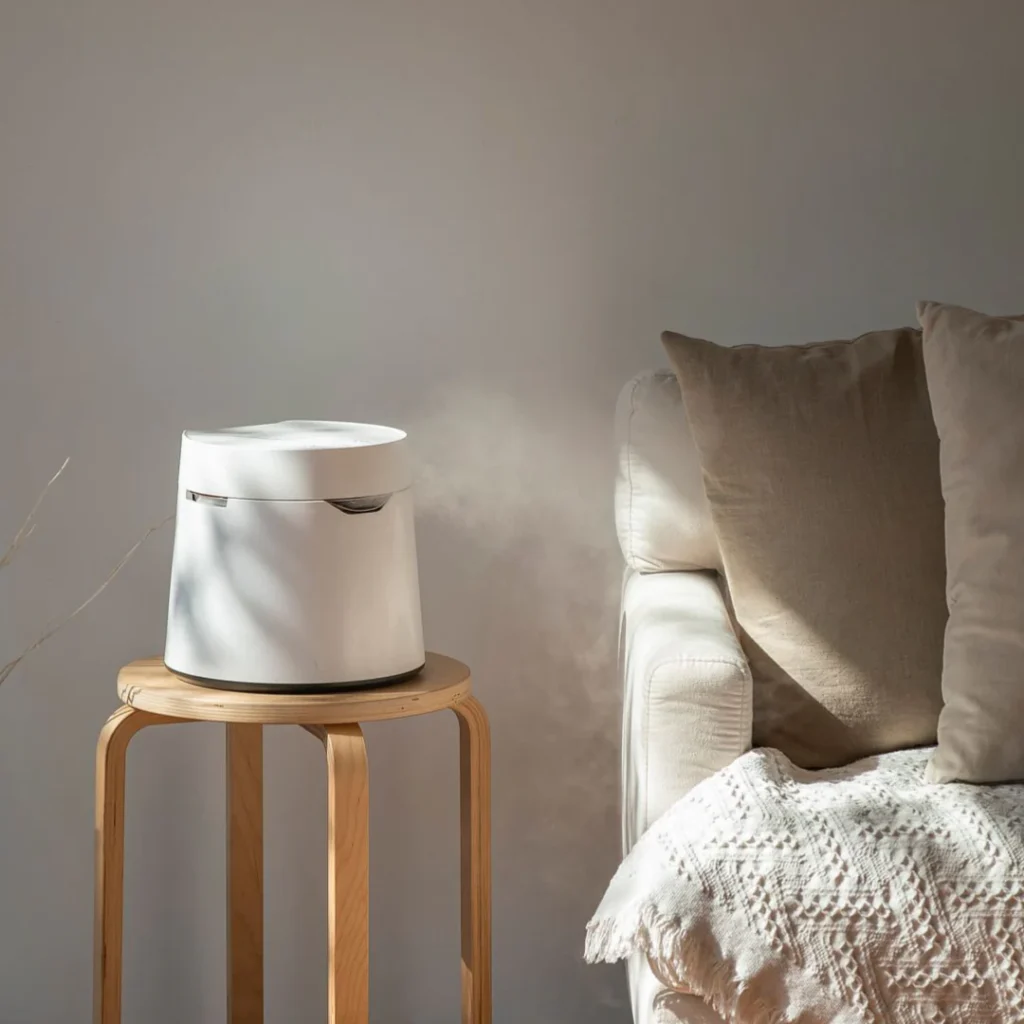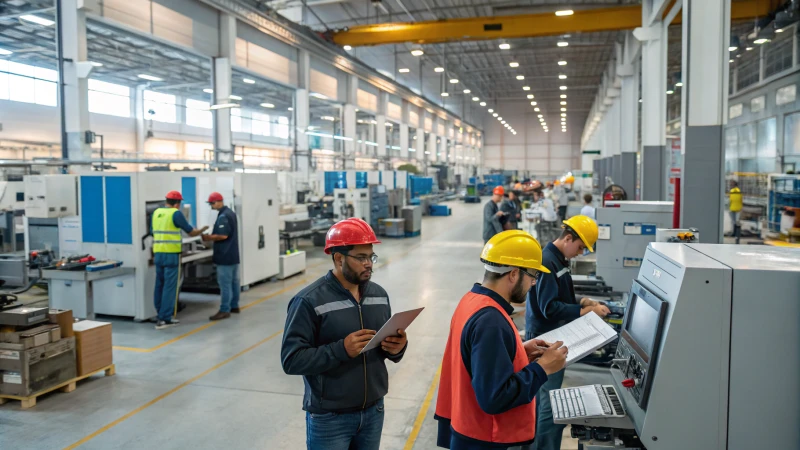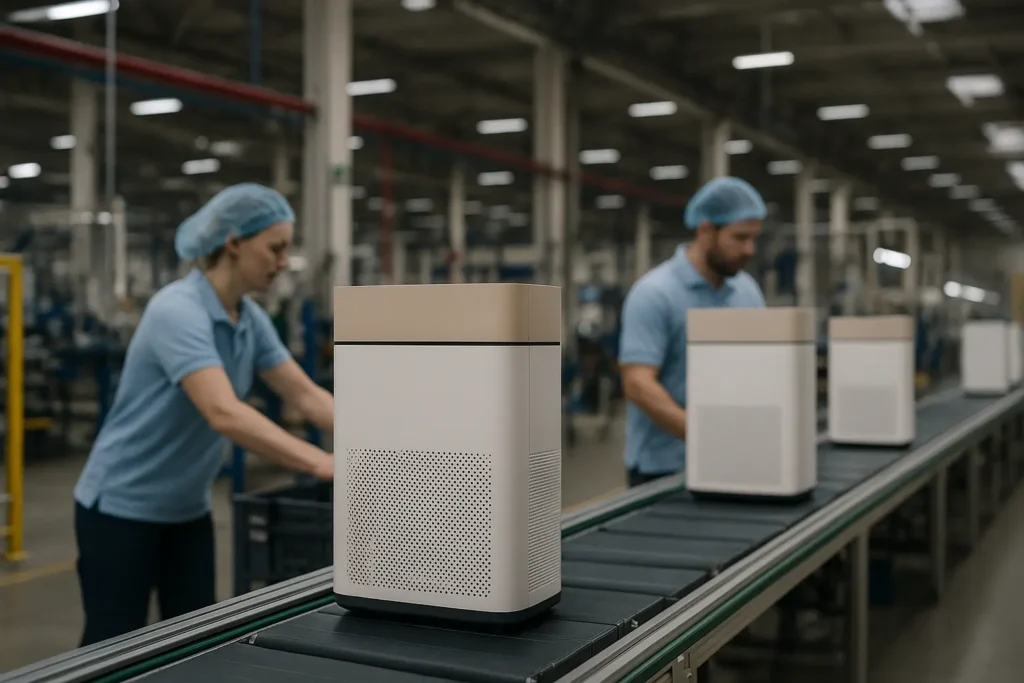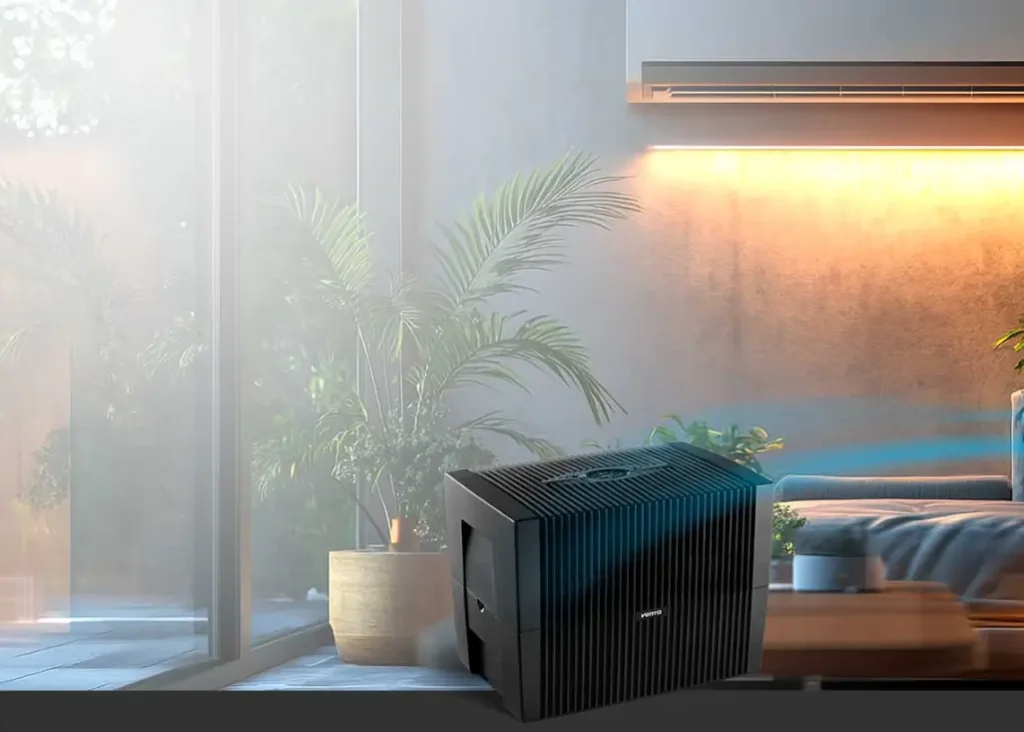الفورمالديهايد هو نوع من المركبات العضوية المتطايرة (VOC) التي تتواجد عادةً في المساحات السكنية. وللأسف، قد يكون التعرض لها ضارًا بعض الشيء. وبالتالي، تحتاج إلى معرفة كيفية التخلص من هذه المادة الكيميائية.
الفورمالديهايد هو مادة كيميائية عادةً ما تكون عديمة اللون ولكنها ذات رائحة كريهة. ويُستخدم في العديد من المواد ومستحضرات التجميل والمواد الكيميائية المنزلية. على سبيل المثال، يمكنك أن تجده في الخشب الرقائقي والمواد اللاصقة والمكياج. حتى في التطبيقات التجارية والصناعية، يوجد الفورمالديهايد أيضًا في التطبيقات التجارية والصناعية.
وبالطبع، يشير ذلك إلى أن الفورمالدهايد له الكثير من الاستخدامات. ولكن في الوقت نفسه، يجب أن يكون الناس حذرين عندما يتعلق الأمر بهذه المادة الكيميائية. فقد أكدت الدراسات بالفعل أن هذه المادة بالتحديد يمكن أن تسبب آثاراً صحية ضارة، وهو ما سنناقشه لاحقاً.
وعلاوة على ذلك، يجب أن تتعلمي كيفية إزالة الفورمالدهايد في أماكن معيشتك، مما يضمن تجنب التعرض له. إحدى هذه الطرق هي استخدام أجهزة تنقية هواء عالية الجودة .
من أين يأتي الفورمالديهايد؟
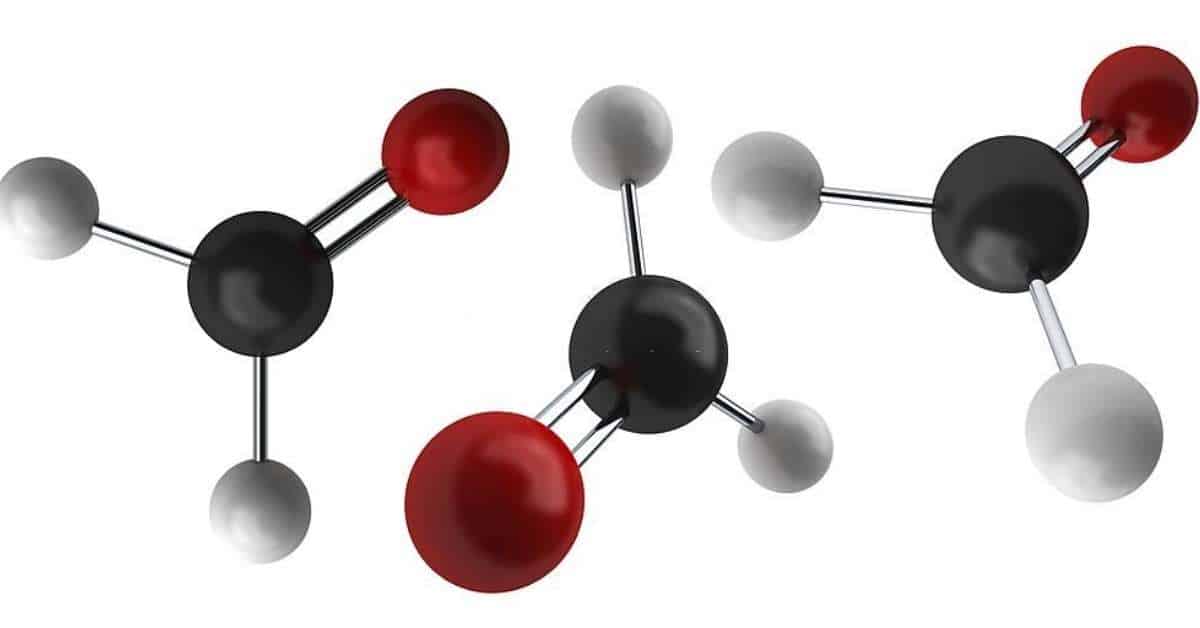
مصدر الصورة: iStockphoto
الفورمالديهايد هو مادة كيميائية شائعة توجد في بيئات مثل مكيفات الهواء والمنتجات الورقية ودخان السجائر وصالونات الأظافر. وهو غاز عديم اللون يسبب تهيج العينين والأنف والحلق، ورائحة الفورمالديهايد هي مزيج كيميائي من حمض الفورميك وحمض الأسيتيك.
الفورمالدهايد مادة سامة للإنسان والحيوان، ويمكن أن يسبب التعرض لها أعراضاً مثل جفاف وتهيج العينين والتهاب الحلق وتهيج الجلد. يُشتق الفورمالديهايد في منزلك من المصادر التالية:
- المنتجات الخشبية المضغوطة، مثل الألواح، وألواح الخشب الحبيبي، والخشب الرقائقي
- العزل الرغوي
- الدهانات وورق الحائط
- أنواع محددة من الأقمشة، مثل المكبس الدائم
- أنواع محددة من وسائل الراحة الشخصية ومستحضرات التجميل
ويذكر أيضًا أن الفورمالديهايد يتولد أيضًا من خلال الاحتراق. عندما تحرق الغاز الطبيعي والبنزين والكيروسين، ينتج الفورمالديهايد. ومن ثم، إذا كان لديك أجهزة داخل منزلك تستخدم هذه الغازات، فمن المحتمل أن تكون معرضًا للفورمالدهايد.
الأمر الآخر الذي يجب أن تعرفه هو أن هذه المادة من بقايا التبغ. ومن ثم، فإن الأسر التي يدخن فيها مدخنو التبغ تعاني أيضًا من هذه المشكلة، سواء كانوا على علم بها أم لا. في الواقع، من المحتمل جدًا أن يكون منزلك يحتوي على آثار من الفورمالديهايد، ولكنك لست على علم بذلك بعد. قد يستدعي الوجود غير المرئي لهذه المواد الكيميائية خدمة أجهزة تنقية الهواء من الشركات المصنعة ذات السمعة الطيبة .
هل الفورمالديهايد طبيعي في المنازل؟
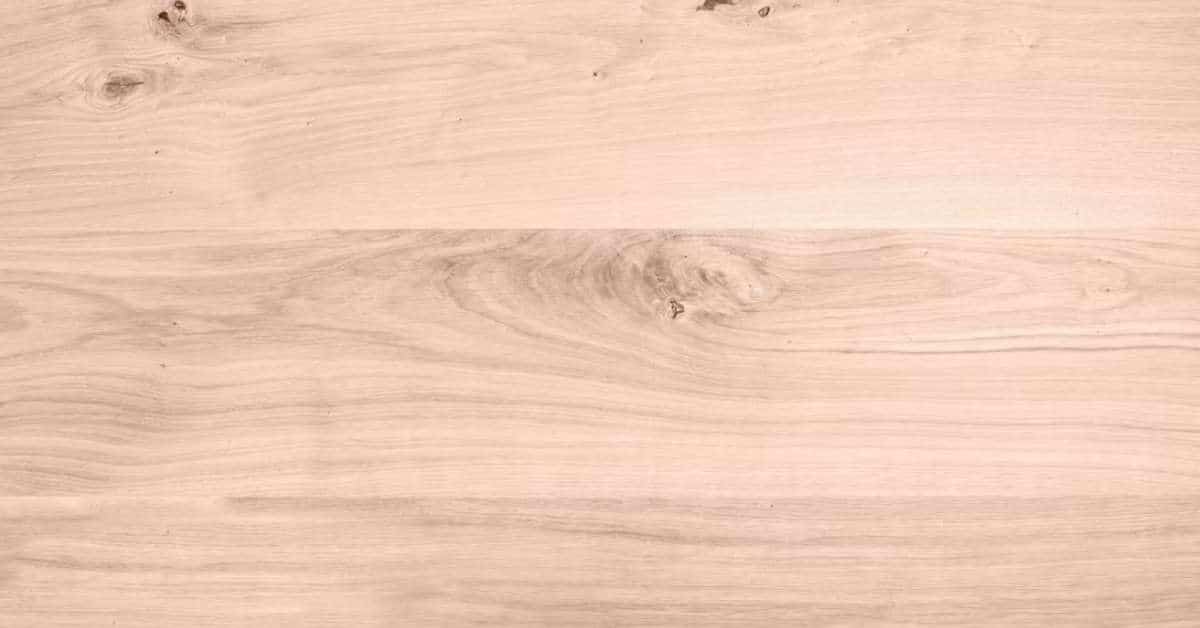
مصدر الصورة: أنسبلاش
كما ذكرنا، يوجد الفورمالدهايد في العديد من الأدوات المنزلية الشائعة، بما في ذلك السجاد والملابس ذات الضغط الدائم، والرغوة في المراتب ودهانات الجدران. ولكن هل هذا يعني أن الفورمالديهايد أمر طبيعي في المنازل؟
استنادًا إلى المعلومات التي نشرتها لجنة سلامة المنتجات الاستهلاكية الأمريكية، فإن الفورمالديهايد موجود عادةً في الهواء الخارجي والداخلي على حد سواء. والخبر السار هو أنها تكون بمستويات منخفضة فقط، وتحديداً أقل من 0.03 جزء في المليون.
ومع ذلك، يشار بوضوح إلى أن الفورمالديهايد لا يحدث بشكل طبيعي. وهذا يعني أنها غير موجودة في تركيبة الهواء "الطبيعية". إنها مادة كيميائية تنتج عن مصادر مختلفة، مثل احتراق المركبات. وبالتالي، لا ينبغي الاستخفاف بوجود الفورمالديهايد في منزلك. يجب عليك معالجة هذه المسألة على الفور قدر الإمكان.
ما هي الآثار الجانبية للتعرض للفورمالديهايد؟
مرة أخرى، يجب أن نؤكد مرة أخرى على أن التعرض للفورمالدهايد ليس أمرًا يجب أن تتعامل معه باستخفاف. فالفورمالديهايد مادة سامة، لذا فهي ضارة للإنسان والحيوان على حد سواء. قد يعني التعرض لفترات طويلة لهذه المادة الكيميائية بمستويات عالية أنك عرضة لأضرار مختلفة، مثل ما يلي:
- الصداع
- الغثيان
- التقيؤ
- صعوبات في التنفس
- تهيج الجلد
ولكن هذه مجرد آثار جانبية بسيطة. يمكن أن يتسبب التعرض لكميات كبيرة من الفورمالديهايد في حدوث أنواع السرطان في البشر . حتى في حيوانات التجارب المخبرية، تم العثور على نفس النتيجة. ومن أمثلة هذه الأنواع السرطانية سرطان البلعوم الأنفي وسرطان الجيوب الأنفية.
وعلاوة على ذلك، فإن الأفراد الذين يعملون في ظروف يوجد فيها الكثير من الفورمالدهايد، مثل المحنطين والعاملين في المستشفيات، معرضون للإصابة بسرطان الدم.
هذه من بين الأسباب التي تجعلك تتجنب التعرض للفورمالدهايد بأي ثمن.
المصادر الشائعة للفورمالديهايد في المنازل

مصدر الصورة: أنسبلاش
لا يعتبر الفورمالديهايد جانباً طبيعياً في منزلك. وبالتالي، يجب أن تكون على دراية بالمصادر الشائعة لهذه المادة الكيميائية. وبهذه الطريقة، ستتمكن من تجنب وجود انبعاثات شديدة من الفورمالدهايد داخل منزلك أو المبنى الخاص بك.
فيما يلي أهم مصادر الفورمالدهايد في المنازل:
الجدران والأرضيات
يمكن أن تكون الأرضيات والجدران في مساحتك مصدراً غنياً بالفورمالدهايد، خاصةً إذا كانت هناك مواد لاصقة مطبوعة عليها. تحتوي العديد من الدهانات على الفورمالديهايد، لذا من الأفضل أن تنتبه لنوع الطلاء الذي ستستخدمه. قد ترغب في اختيار تلك التي تحتوي على مركبات عضوية متطايرة منخفضة أو خالية من المركبات العضوية المتطايرة (VOCs).
إذا كانت هناك ألواح خشبية على جدران المبنى أو المنزل الخاص بك، فهناك احتمال كبير لوجود الفورمالدهايد.
أثاث غرف النوم
تُصنع العديد من أنواع أثاث غرف النوم من خلال استخدام مواد الخشب المضغوط، مثل الألواح الخشبية المضغوطة، والخشب الرقائقي، والألواح الليفية. وعلى الرغم من أنها تبدو غير ضارة، إلا أن هذه المواد قد تمت معالجتها باستخدام الفورمالدهايد.
إذا كان مكتوب على الأثاث أنه مثبط للحريق، فهناك أيضاً احتمال احتوائه على الفورمالدهايد. وهذه مشكلة لأنه في درجة حرارة الغرفة يتحول الفورمالديهايد إلى غاز ويتحول إلى انبعاثات.
المنتجات الشخصية والمنزلية
تحتوي العديد من المنتجات المنزلية والمستحضرات الشخصية على الفورمالدهايد. على سبيل المثال، تتم معالجة البلسم، ومثبتات الشعر، والمكياج في أماكن تحتوي على الفورمالدهايد. في الواقع، هناك احتمال أن يكون الفورمالديهايد جزءًا من تركيباتها.
قد تُطلق هذه المنتجات الفورمالديهايد وغيره من المركبات العضوية المتطايرة في الهواء أثناء وجودها على الرفوف أو الخزائن. لذا احرص على أن تكون محكمة الإغلاق بشكل صحيح وخالية من التعرض لدرجات الحرارة العالية.
مواقد الغاز
ومن المثير للاهتمام أن الغاز الطبيعي من بين الاستثناءات القليلة التي لا يتحمل فيها المصنعون مسؤولية انبعاثات الفورمالديهايد. فعند استخدام مواقد الغاز، يطلق الغاز الطبيعي تلقائيًا الفورمالديهايد وأول أكسيد الكربون وثاني أكسيد النيتروجين في الهواء.
لهذا السبب، من الضروري وجود شفاط عادم في مطبخك إذا كنت تستخدمين مواقد الغاز في أي وقت. وبهذه الطريقة، سيتم طرد هذه المخلفات من مطبخك، مما يمنعك من استنشاقها.
ما أهمية تنقية الفورمالديهايد؟
لقد ذكرنا بالفعل المخاطر المحتملة للفورمالدهايد على صحتك. ولهذا السبب، تحتاج إلى تعلم طرق مختلفة حول كيفية الحد من وجوده. فأنت تريد أن يكون منزلك خالٍ من هذه المادة الكيميائية قدر الإمكان.
سنقدم في الأقسام التالية العديد من الطرق التي تم اختبارها وإثبات فعاليتها في إزالة الفورمالديهايد وأنواع مختلفة من المركبات العضوية المتطايرة في أماكن المعيشة.
إضافة جهاز تنقية الهواء للتخلص من الفورمالديهايد
إذا كنت تريد طريقة مضمونة لإزالة الفورمالدهايد من الهواء، فعليك الاستثمار في جهاز تنقية الهواء. لقد سمع الكثير منكم بالفعل عن أجهزة تنقية الهواء هذه. وهي في الأساس أجهزة تلتقط الملوثات المختلفة المحمولة في الهواء.
ولكن في الوقت نفسه، لا يدرك الكثيرون أن هذه الأجهزة لا تقتصر على حبوب اللقاح والمواد المسببة للحساسية ومسببات الأمراض فقط. فمن المعروف أيضاً أن أجهزة تنقية الهواء فعالة ضد المواد العالقة والمواد الكيميائية والملوثات المسببة للروائح الكريهة.
محددة أجهزة تنقية الهواء المعتمدة من AHAM يمكنها التعامل مع الفورمالدهايد بشكل صحيح. تلك التي تحتوي على الفلاتر المناسبة ستكون قادرة على تقليل وجود الفورمالدهايد في أي مساحة معينة. بعد فترة قصيرة، ستعرف كيف يمكن لأجهزة تنقية الهواء القيام بهذا العمل الفذ.
ما أهمية جهاز تنقية الهواء لتحسين جودة الهواء؟
غالبًا ما تتأثر جودة الهواء الداخلي لديك بالملوثات المختلفة. بدءاً من الغبار خارج منزلك وصولاً إلى شعر حيوانك الأليف، يمكن لهذه الأشياء أن تقلل تدريجياً من قابلية الهواء الداخلي للتنفس بشكل عام.
بالطبع، هناك العديد من الطرق التي يمكنك من خلالها تحسين الهواء الداخلي الملوث. يمكننا سرد طرق متعددة لذلك. ومع ذلك، إذا كنت تريد طريقة مضمونة وغير معقدة، فعليك اختيار استخدام جهاز تنقية الهواء.
ففي النهاية، هذه الأجهزة مصممة للقيام بمهمة واحدة، وهي التخلص من الجسيمات المحمولة في الهواء التي قد تسبب مشاكل صحية مختلفة. مع أجهزة تنقية الهواء، يمكنك أن تضمن الحصول على هواء نقي يسمح لك بالتنفس في منزلك.
جهاز تنقية الهواء للفورمالديهايد
تعمل أجهزة تنقية الهواء على إزالة أي جزيئات صغيرة من الغبار أو الأوساخ من الهواء، مما يقلل من فرص الإصابة بحساسية الجهاز التنفسي والربو. تقوم أجهزة تنقية الهواء بإزالة الجسيمات ميكانيكياً عن طريق إجبار تدفق الهواء من خلال مرشحات أجهزة تنقية الهواء.
أحد فلاترها، الذي يسمى فلتر الكربون المنشط أو فلتر الفحم، هو المسؤول عن إزالة مختلف المركبات العضوية المتطايرة والمواد الكيميائية في الهواء. عندما يمر الهواء من خلال فلتر الكربون، يتم "تكسير" هذه المواد، مما يضمن عدم إطلاقها مرة أخرى في الهواء.
وبالتالي، إذا كان جهاز تنقية الهواء يحتوي على فلاتر كربون، فسيكون مكانك الداخلي خاليًا من المواد الكيميائية الضارة المحتملة. إنه فلتر مهم يجب أن يكون موجوداً في جهاز تنقية الهواء إذا كانت مشكلتك مرتبطة بهذه السموم والمواد الغازية.
هل جهاز تنقية الهواء للفورمالدهايد آمن؟
نعم. أجهزة تنقية الهواء التي تستخدم الفلاتر آمنة بشكل عام. لا تنبعث من هذه الأجهزة انبعاثات ضارة يمكن أن تسبب الحساسية وأمراض الجهاز التنفسي. ولا تحتوي هذه الفلاتر على مواد كيميائية أيضاً. فهي تستطيع التقاط الملوثات من خلال عملية الترشيح القياسية التي تُستخدم منذ عدة قرون بالفعل.
عندما تقوم أجهزة تنقية الهواء هذه بإزالة الفورمالديهايد، لا يتم إطلاق أي مواد متبقية في الهواء. وهذا هو مدى "نظافة" و"سلاسة" أجهزة تنقية الهواء هذه.
النوع الوحيد من أجهزة تنقية الهواء الذي يجب أن تنتبه إليه هو مولد الأوزون. وكما يوحي اسمه، فإن مولد الأوزون مصمم لتقليل الأوزون الغازي في الهواء. ويقال إن غازات الأوزون هذه تعمل على تحييد الملوثات في الهواء. ومع ذلك، ضع في اعتبارك أن فعاليته ليست مثالية مقارنةً بأجهزة تنقية الهواء القائمة على الفلتر. وعلاوة على ذلك، فإن الأوزون مهيّج للرئة قد يضر بصحتك.
كيف تعمل أجهزة تنقية الهواء على إزالة الفورمالديهايد؟
كما ذكرنا سابقاً، تحتوي أجهزة تنقية الهواء على مرشحات الكربون المنشط. بالطبع، لا يوجد سحر في فلاتر الكربون هذه. فهي تتبع مبدأ الامتزاز الذي تم اختباره وتجربته.
الامتزاز هو نوع من التفاعل الكيميائي. ثم يتم احتجاز الجسيمات التي تتعرض لهذه العملية في البنية المسامية للمرشح. ومع مرور الوقت، تتكسر هذه المواد، مما يضمن عدم وجود بقايا عليها.
نظرًا لفعالية مرشحات الكربون، عادةً ما تستخدمها الصناعات المختلفة في تجميع المواد الكيميائية والغازات المحمولة في الهواء، بالإضافة إلى المواد المسببة للروائح. وبالطبع، تُستخدم نفس الآلية أيضًا في أجهزة تنقية الهواء.
إزالة الفورمالديهايد بواسطة أجهزة تنقية الهواء: خطوة بخطوة
إليك كيفية إزالة أجهزة تنقية الهواء للفورمالديهايد والمركبات العضوية المتطايرة. بشكل عام، العملية بسيطة لكنها فعالة.
- يقوم جهاز تنقية الهواء بسحب الهواء نحوه من خلال استخدام مراوحه.
- وفي الوقت نفسه، يمر الهواء عبر عدة طبقات من المرشحات. وبمجرد وصوله إلى فلتر الكربون، يتم احتجاز المواد الكيميائية والمواد في الطبقة المسامية من الفلتر. وهذا هو المكان الذي يحدث فيه الامتزاز.
- وبعد الانتهاء من فلتر الكربون، يتم إطلاق الهواء مرة أخرى إلى الغرفة.
تتكرر هذه العملية حتى يصبح الهواء في غرفة معينة خاليًا بالفعل من الملوثات المختلفة.
كم من الوقت يستغرق استقرار الفورمالديهايد بعد إزالته؟
يعتمد ذلك على شدة انبعاث الفورمالدهايد في مساحتك. على سبيل المثال، إذا كان تركيز الفورمالدهايد منتشرًا، فمن الممكن أن يستغرق الأمر بعض الوقت قبل أن يتمكن جهاز تنقية الهواء من إزالة المادة الكيميائية المذكورة.
قد يستغرق الأمر بعض الوقت قبل إزالة آثار الفورمالدهايد في المساحات الكبيرة، خاصةً إذا كان جهاز تنقية الهواء الذي لديك مصنفاً ليكون فعالاً في المساحات الصغيرة فقط. وهذا يقودنا إلى القسم التالي.
أشياء يجب مراعاتها عند شراء جهاز تنقية الهواء من الفورمالديهايد
أنت تريد جهاز تنقية هواء يوفر نتائج شاملة في إزالة الفورمالديهايد. وبالتالي، تحتاج إلى اختيار الجهاز المناسب لك. فيما يلي بعض الجوانب المهمة التي تحتاج إلى أخذها في الاعتبار.
- المساحة المربعة - لكل جهاز من أجهزة تنقية الهواء نطاقه الفعال المميز. على سبيل المثال، يتم تصنيف جهاز تنقية هواء على مساحة 300 قدم مربع بينما يعمل البعض الآخر على مساحة 700 قدم مربع أو أكبر. ما عليك القيام به هنا هو العثور على جهاز تنقية هواء له نطاق فعّال يتناسب مع المساحة المربعة للغرفة أو المساحة التي تريد تنقيتها. على سبيل المثال، إذا كانت مساحة غرفتك 500 قدم مربع، فابحث عن جهاز تنقية هواء يتناسب مع هذه المساحة.
- فلتر الكربون المنشط - مرة أخرى، يجب أن نؤكد على أهمية فلتر الكربون المنشط في إزالة الفورمالديهايد. إنه الفلتر الوحيد الذي ثبتت فعاليته ضد المواد الكيميائية والمواد. فلاتر HEPA لن تفعل الكثير لهذه المركبات الغازية.
أجهزة تنقية الهواء الأفضل لإزالة الفورمالديهايد
تتفوق العديد من أجهزة تنقية الهواء الموجودة في السوق اليوم في إزالة الفورمالدهايد. أجهزة تنقية الهواء هذه هي أفضل رهان لك للتحكم في انبعاثات الفورمالدهايد في منزلك. شاهدها الآن:
| التغطية | أنواع الفلاتر | |
|---|---|---|
| هيسو إير موديل HA139 | 516 قدماً مربعاً | فلتر HEPA، فلتر الكربون المنشط، فلتر الكربون المنشط، الفلتر المسبق، ضوء UVC |
| هيسو إير موديل HA-1601 | 1011 قدم مربع | فلتر HEPA، فلتر الكربون المنشط، فلتر الكربون المنشط، الفلتر المسبق، ضوء UVC |
| هيسو إير موديل HA-1968 | 1,937 1 قدم مربع | فلتر HEPA، فلتر الكربون المنشط، فلتر الكربون المنشط، الفلتر المسبق، ضوء UVC |
1. هيسو إير موديل HA139
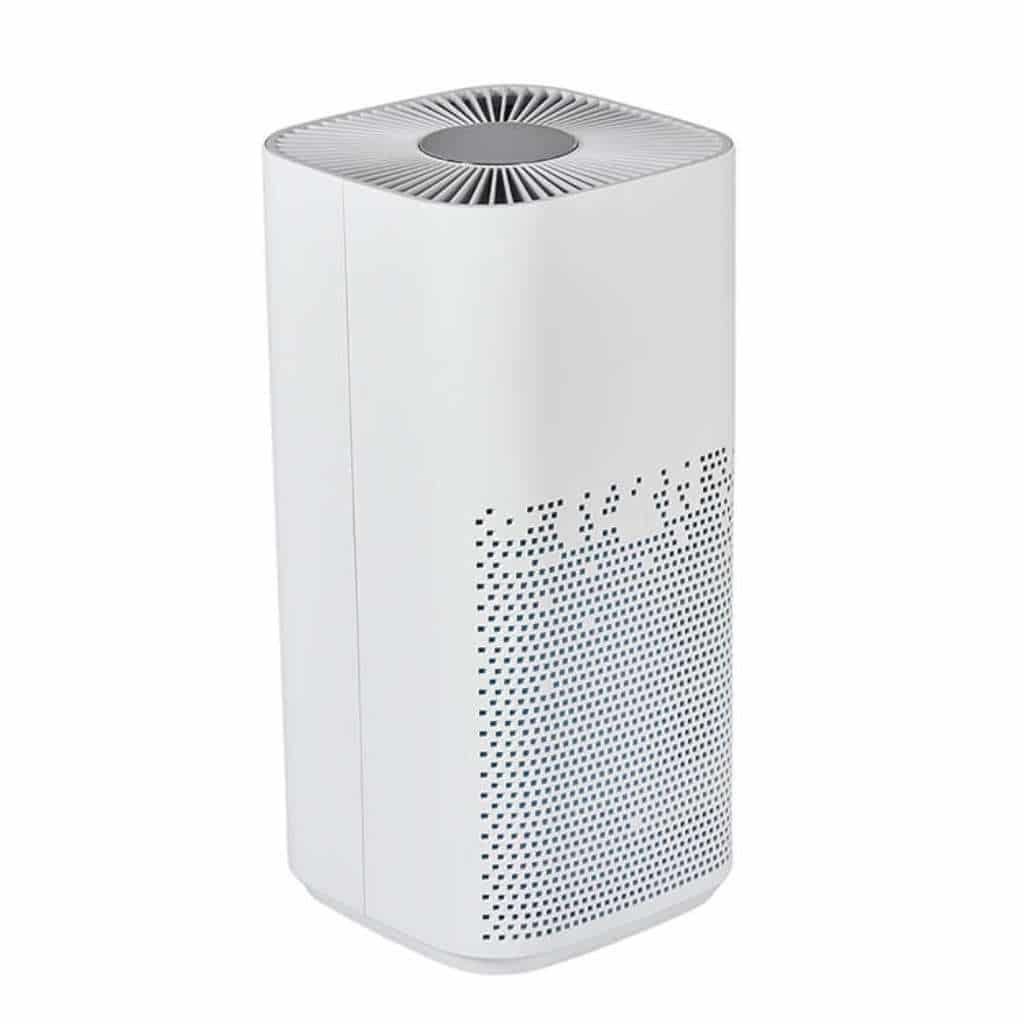
مصدر الصورة: هيسو إير
خذ جهاز تنقية الهواء من طراز HA139 كمعيار لإزالة الفورمالدهايد. يتميز جهاز تنقية الهواء هذا بفلتر كربون نشط عالي الجودة ثبتت فعاليته في مكافحة الفورمالديهايد وأشكال أخرى من المركبات العضوية المتطايرة. وبفضل مروحته القوية وتدفق الهواء، يمكنه بسهولة سحب الانبعاثات الموجودة في مساحتك، مما يسمح بتنقيتها من الهواء.
هذه الآلية المحددة هي السبب وراء استخدام الموديل HA139 بشكل شائع في التطبيقات التجارية والصناعية. عندما تكون هناك حاجة لإزالة المواد الكيميائية الموجودة في الهواء بشكل مكثف، فإن هذا الجهاز موثوق إلى حد كبير. في الوقت نفسه، فإن منظف الهواء هذا فعال أيضًا ضد الملوثات المختلفة المحمولة في الهواء، وذلك بفضل مجموعة كبيرة من الفلاتر الموجودة فيه.
| المحترفون | CONS |
|---|---|
| تشغيل بسيط وهادئ في نفس الوقت أداء موفر للطاقة يوفر ترشيحاً شاملاً للهواء |
لا توجد عيوب معروفة |
2. جهاز تنقية الهواء HA-1601 من هيسو إير HA-1601
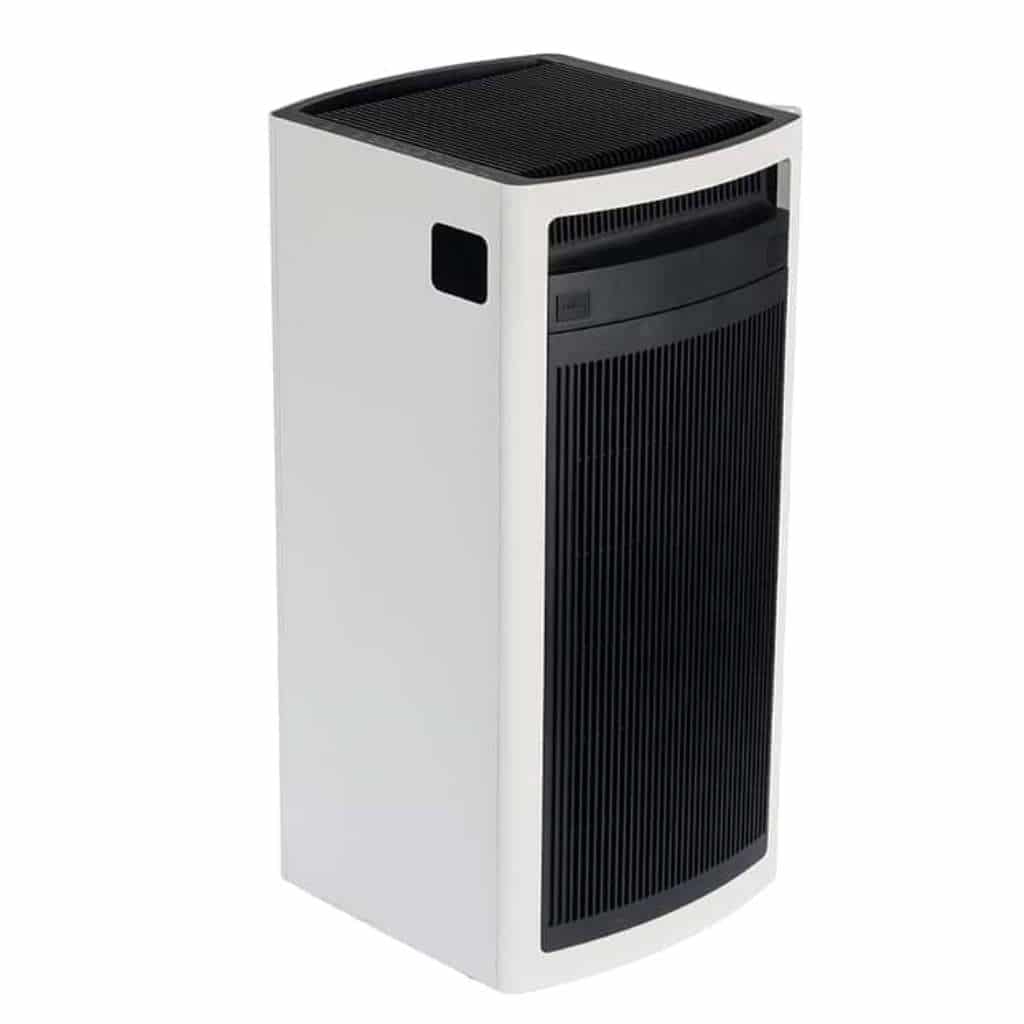
مصدر الصورة: هيسو إير
جهاز تنقية الهواء الآخر الذي يمكنك الوثوق به لإزالة الفورمالديهايد هو جهاز تنقية الهواء هيسو إير HA-1601. يتميز جهاز تنقية الهواء هذا بتقنية فلتر HEPA الحاصلة على براءة اختراع والتي تُدخل تقنية محسنة لالتقاط البكتيريا والفيروسات في نظام الترشيح الخاص به. ونتيجة لذلك، يمكنه التقاط أنواع مختلفة من الملوثات المحمولة جواً، حتى تلك المراوغة جداً.
يتميز فلتر الكربون المنشط الخاص به بكفاءته العالية في تكسير المركبات العضوية المتطايرة والمواد الكيميائية الأخرى في الهواء. فهو لا يواجه أي مشاكل في الحد من وجود الفورمالديهايد، مما يضمن أن الهواء الداخلي آمن للتنفس. كما أنه مصمم للغرف الكبيرة، حيث يغطي جهاز تنقية الهواء هذا مساحة تصل إلى 1,011 قدم مربع. ونظراً لأنه جهاز تنقية هواء معتمد من AHAM، يمكنك ضمان أدائه الموفر للطاقة والذي يدوم طويلاً.
| المحترفون | CONS |
|
|
3. هيسو إير موديل HA-1968
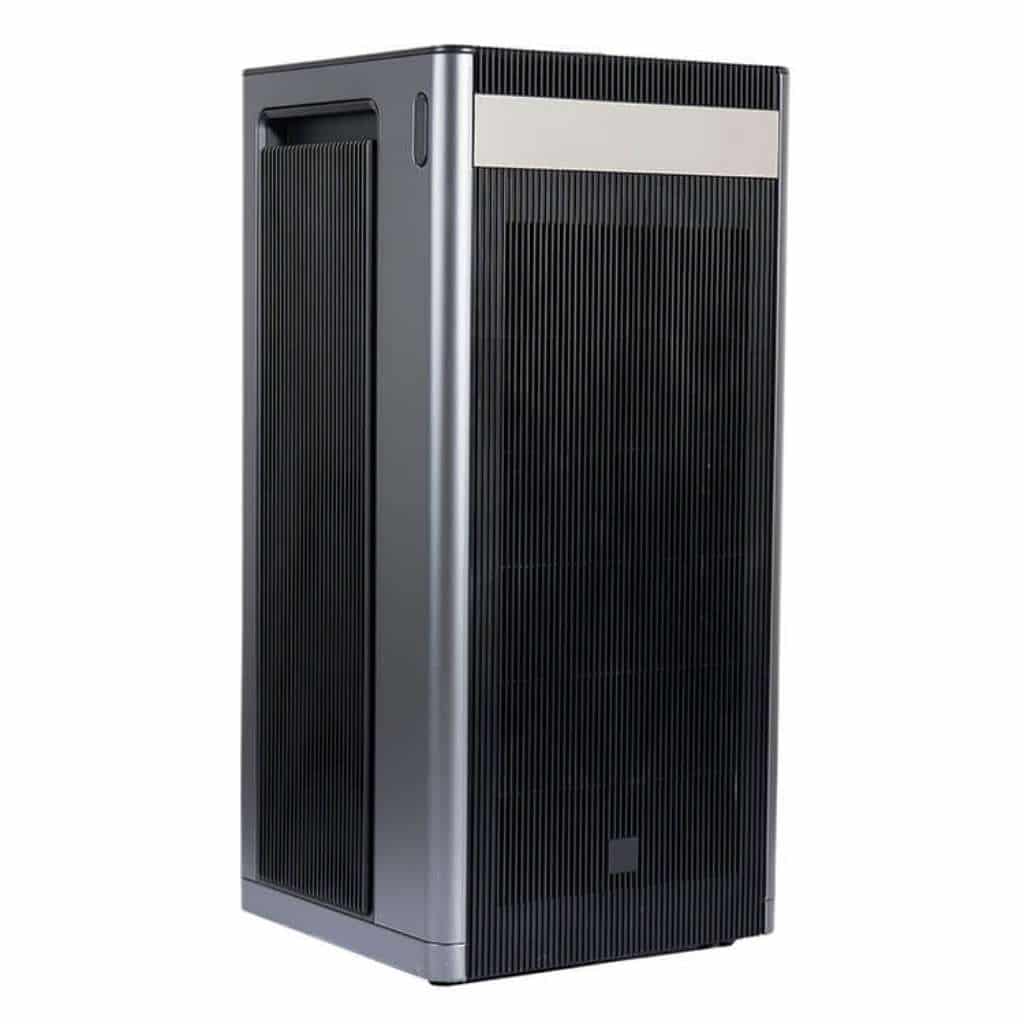
مصدر الصورة: هيسو إير
جهاز تنقية الهواء Medify MA-50 هو مزيل فورمالدهايد قوي. فهو يوفر نظام ترشيح فعال قادر على إزالة مختلف المواد والمواد الكيميائية في الهواء. يضمن فلتر الكربون الخاص به التخلص من آثار المركبات العضوية المتطايرة، بما في ذلك رائحتها. ونظراً لأدائه الفعال، أصبح جهاز تنقية الهواء هذا خياراً موثوقاً للتطبيقات السكنية والتجارية بسبب أدائه الفعال.
وعلاوة على ذلك، فإن جهاز تنقية الهواء من هيسو إير موديل HA-1968 هو جهاز رقمي، مما يضمن لك إمكانية تشغيله بسهولة. فهو مزوّد بلوحة تعمل باللمس تتيح لك ضبط إعداداته المختلفة مع مستشعر PM2.5 ومستشعر اختياري لدرجة الحرارة والرطوبة بحيث يمكنه مراقبة جودة الهواء في الأماكن الداخلية.
| المحترفون | CONS |
|
|
كيفية منع الفورمالديهايد بعد الإزالة؟
إن منع انبعاث الفورمالدهايد أمر صعب للغاية، حيث يمكن أن تكون هناك مصادر متعددة له. ولكن في الوقت نفسه، فإن الحل الأمثل لمشكلتك هو التأكد من عدم إحضار أي أغراض ووسائل راحة تحتوي على الفورمالدهايد.
إحدى طرق القيام بذلك هي أن تكوني انتقائية في استخدام الدهانات وورق الجدران. فهي تحتوي على الفورمالدهايد، ولا يتوقف انبعاثها حتى لو كانت جافة بالفعل. استخدم قدر الإمكان تلك الدهانات الخالية من الفورمالديهايد.
إذا كنت تبحث عن ترقيات خشبية، ابحث عن الخشب الصلب. تخطى الخشب الرقائقي، لأنه يحتوي على الكثير من الفورمالدهايد. إذا كان هذا هو الخيار الوحيد المتاح، تأكد من أنه متوافق مع معايير CARB CARB ATCM . مرة أخرى، المفتاح هنا هو التأكد من عدم استخدام أي مواد تحتوي على الفورمالديهايد. وإلا فلن تكون هناك نهاية لهذه المشكلة.
طرق أخرى لإزالة الفورمالديهايد في الهواء
نظراً لأن الفورمالديهايد مادة سامة، فمن الضروري أن تكون قادراً على تقليل وجودها في منزلك ومبانيك. لذا وبصرف النظر عن استخدام أجهزة تنقية الهواء، يجب أن تتعلم أيضاً تدابير أخرى لإزالة الفورمالدهايد، مثل التدابير التالية:
كن حكيماً في اختيارك للأثاث
صدّق أو لا تصدق، يمكن أن يصبح الأثاث في منزلك مصدراً ممتازاً للفورمالدهايد. ضع في اعتبارك أن الخزائن والأثاث المصنوع من مواد مضغوطة، مثل MDF والخشب الرقائقي، قد تحتوي على الفورمالديهايد وتنتج عنه.
وفقًا للخبراء، قد ينخفض انبعاث هذه المرافق المنزلية بعد عشرة أشهر. لكن التهديد سيظل قائماً. فماذا علينا أن نفعل هنا؟
حسناً، إذا كنت تخطط لشراء مجموعات جديدة من الأثاث لمنزلك الذي أعيد تصميمه حديثاً، يمكنك التفكير في خيارات أكثر أماناً. ومن الأمثلة على ذلك الأثاث المنجد. علاوة على ذلك، يجب أن تفضل الأثاث المصنوع من الخشب الصلب. إذا كانت قطع الأثاث في منزلك خالية من الفورمالدهايد، فلا داعي لإزالتها بعد الآن!
فتح نافذة
الحل الآخر الذي قد ترغب في اختياره هو فتح النوافذ في منزلك. سيسمح ذلك بتدوير الهواء، مما يؤدي إلى خروج الهواء من الداخل. سيساعد ذلك على التخفيف من وجود الفورمالديهايد في الهواء.
ولكن كن حذراً في القيام بذلك. حاول أن تحد من الوقت الذي ستفتح فيه نوافذك، خاصةً إذا كنت تقيم في المدينة. وإلا فإنك ستدعو الملوثات الخارجية الأخرى للدخول والاستقرار في مساحتك.
تقليل الرطوبة والحرارة
إن أحد أفضل الخيارات لتقليل وجود الفورمالدهايد في مكانك هو تنظيم الحرارة والرطوبة. وفقاً لوكالة حماية البيئة, تسرِّع الحرارة من إطلاق الفورمالديهايد في الهواء. إذا كان منزلك يحتوي على عناصر تحتوي على هذه المادة، فإن درجات الحرارة المرتفعة تسرّع من انبعاثها.
الشيء الآخر الذي يجب الانتباه إليه هو الرطوبة. عندما تكون الرطوبة عالية جداً، قد يؤدي ذلك إلى إطلاق الفورمالديهايد. ولحسن الحظ، يمكنك مواجهة هذه المشكلة من خلال استخدام مزيل الرطوبة.
ضع النباتات التي تزيل الفورمالديهايد
تمتص النباتات الفورمالديهايد، وهو مادة مهيجة تلوث الهواء. ومع ذلك، يمكن لبعض النباتات امتصاصه بكفاءة أكبر من غيرها، لذلك إذا كنت قلقاً بشأنه، فقد ترغب في زراعة بعض النباتات. تتضمن بعض النباتات الشائعة التي يمكنها امتصاص الفورمالديهايد ما يلي:
- فيلوديندرون
- بوثوس ذهبي
- نباتات العنكبوت
قد ترغب في استكشاف بعض النباتات الأخرى التي ممتازة في إزالة السموم. إذا كنت تعاني من مشاكل مع أنواع مختلفة من المواد الكيميائية، فقد يكون من الضروري ملء منزلك بنخيل الأريكا أو نخيل السيدة.
الخاتمة
من الواضح هنا أن التعرض للفورمالدهايد ورائحته له بعض التداعيات على رائحتك. وبالتالي، من الضروري أن تكون قادراً على إزالة هذه المادة الكيميائية من أماكن معيشتك لضمان عدم المساس برفاهيتك.
من بين الحلول التي ذكرناها هنا، فإن استخدام جهاز تنقية الهواء هو الأكثر فعالية عندما يتعلق الأمر بإزالة الرائحة وبقايا الفورمالديهايد المحمولة في الهواء. لذلك، هناك حاجة إلى الاستثمار في منظفات هواء عالية الجودة من الشركات المصنعة ذات السمعة الطيبة، مثل HisoAir. قم بزيارة هيسو إير وتحقق من أحكامه العديدة الخاصة بأجهزة تنقية الهواء!
راجع المدونات المفيدة الأخرى هنا!



